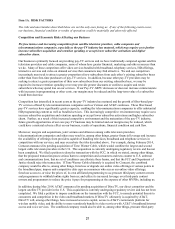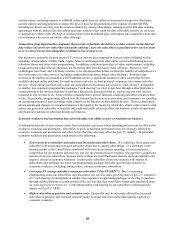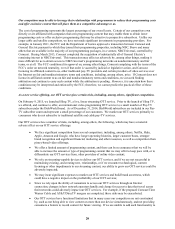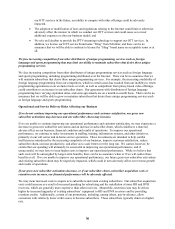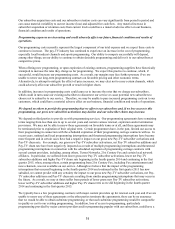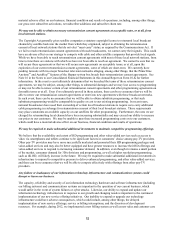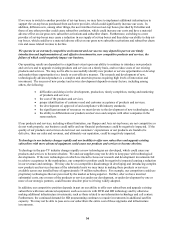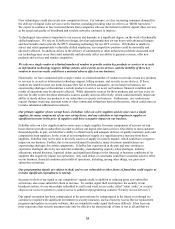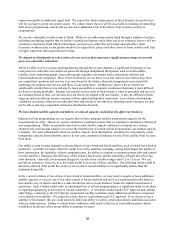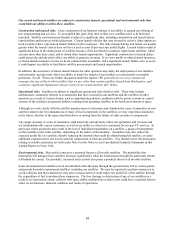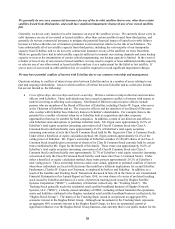Dish Network 2014 Annual Report Download - page 47
Download and view the complete annual report
Please find page 47 of the 2014 Dish Network annual report below. You can navigate through the pages in the report by either clicking on the pages listed below, or by using the keyword search tool below to find specific information within the annual report.
37
37
Our owned and leased satellites are subject to construction, launch, operational and environmental risks that
could limit our ability to utilize these satellites.
Construction and launch risks. A key component of our business strategy is our ability to expand our offering of
new programming and services. To accomplish this goal, from time to time, new satellites need to be built and
launched. Satellite construction and launch is subject to significant risks, including construction and launch delays,
launch failure and incorrect orbital placement. Certain launch vehicles that may be used by us have either unproven
track records or have experienced launch failures in the recent past. The risks of launch delay and failure are usually
greater when the launch vehicle does not have a track record of previous successful flights. Launch failures result in
significant delays in the deployment of satellites because of the need both to construct replacement satellites, which
can take more than three years, and to obtain other launch opportunities. Significant construction or launch delays
could materially and adversely affect our ability to generate revenues. If we were unable to obtain launch insurance,
or obtain launch insurance at rates we deem commercially reasonable, and a significant launch failure were to occur,
it could impact our ability to fund future satellite procurement and launch opportunities.
In addition, the occurrence of future launch failures for other operators may delay the deployment of our satellites
and materially and adversely affect our ability to insure the launch of our satellites at commercially reasonable
premiums, if at all. Please see further discussion under the caption “We generally do not carry commercial
insurance for any of the in-orbit satellites that we use, other than certain satellites leased from third parties, and
could face significant impairment charges if any of our owned satellites fail” below.
Operational risks. Satellites are subject to significant operational risks while in orbit. These risks include
malfunctions, commonly referred to as anomalies that have occurred in our satellites and the satellites of other
operators as a result of various factors, such as manufacturing defects, problems with the power systems or control
systems of the satellites and general failures resulting from operating satellites in the harsh environment of space.
Although we work closely with the satellite manufacturers to determine and eliminate the cause of anomalies in new
satellites and provide for redundancies of many critical components in the satellites, we may experience anomalies
in the future, whether of the types described above or arising from the failure of other systems or components.
Any single anomaly or series of anomalies could materially and adversely affect our operations and revenues and
our relationship with current customers, as well as our ability to attract new customers for our pay-TV services. In
particular, future anomalies may result in the loss of individual transponders on a satellite, a group of transponders
on that satellite or the entire satellite, depending on the nature of the anomaly. Anomalies may also reduce the
expected useful life of a satellite, thereby reducing the channels that could be offered using that satellite, or create
additional expenses due to the need to provide replacement or back-up satellites. You should review the disclosures
relating to satellite anomalies set forth under Note 8 in the Notes to our Consolidated Financial Statements in this
Annual Report on Form 10-K.
Environmental risks. Meteoroid events pose a potential threat to all in-orbit satellites. The probability that
meteoroids will damage those satellites increases significantly when the Earth passes through the particulate stream
left behind by comets. Occasionally, increased solar activity also poses a potential threat to all in-orbit satellites.
Some decommissioned satellites are in uncontrolled orbits that pass through the geostationary belt at various points,
and present hazards to operational satellites, including our satellites. We may be required to perform maneuvers to
avoid collisions and these maneuvers may prove unsuccessful or could reduce the useful life of the satellite through
the expenditure of fuel to perform these maneuvers. The loss, damage or destruction of any of our satellites as a
result of an electrostatic storm, collision with space debris, malfunction or other event could have a material adverse
effect on our business, financial condition and results of operations.


